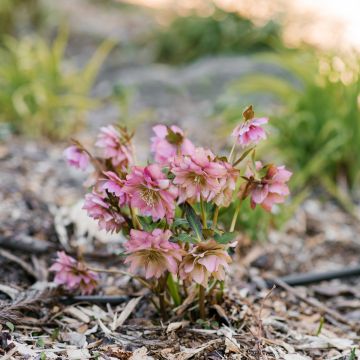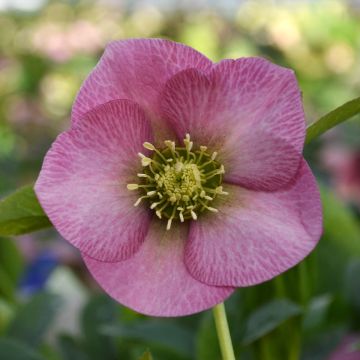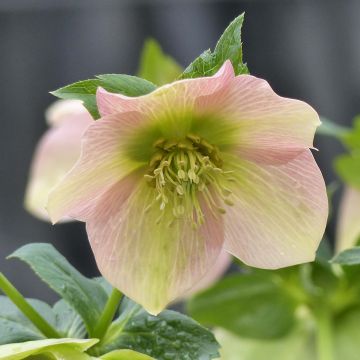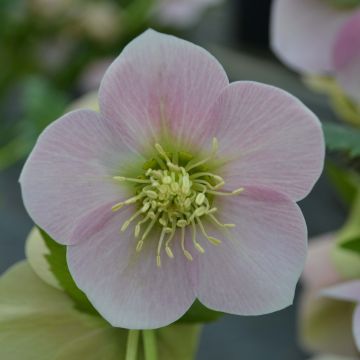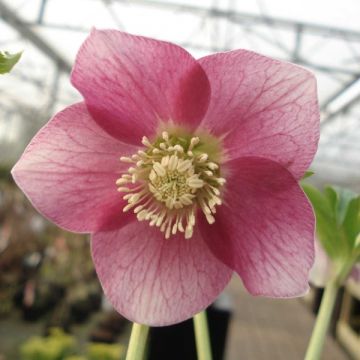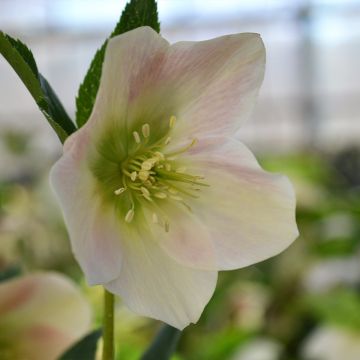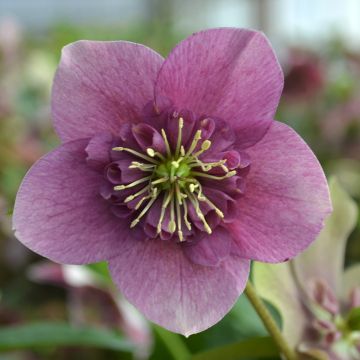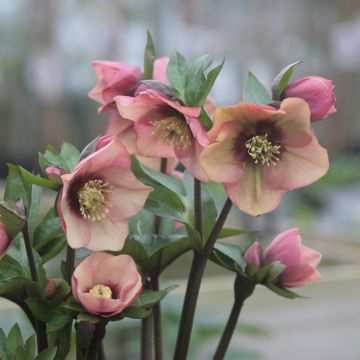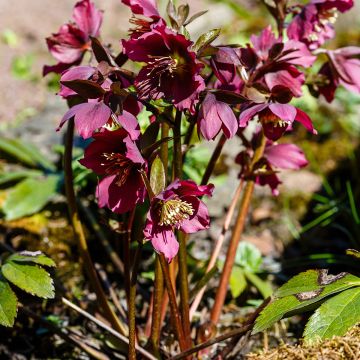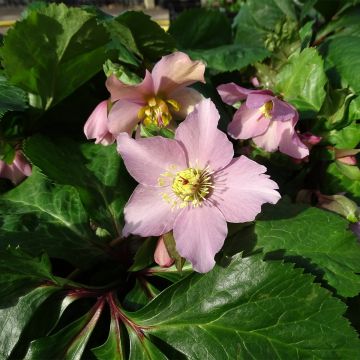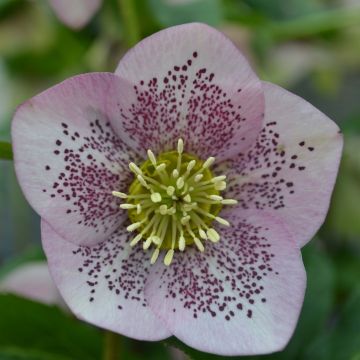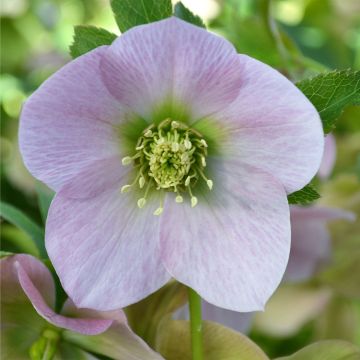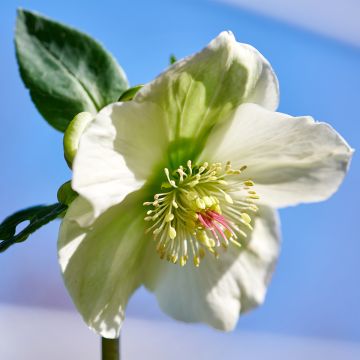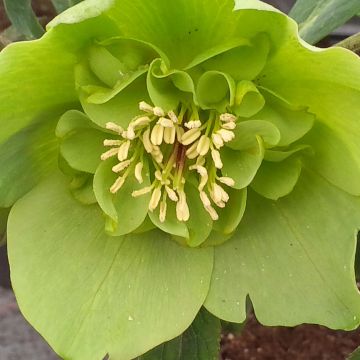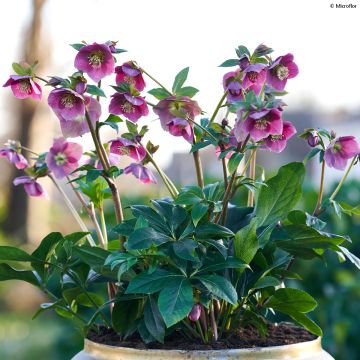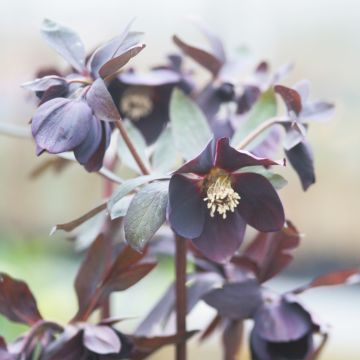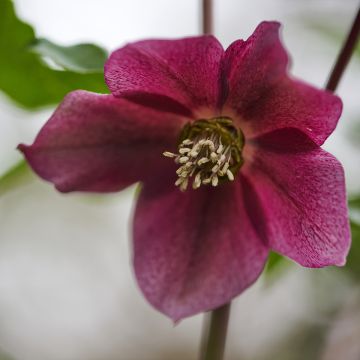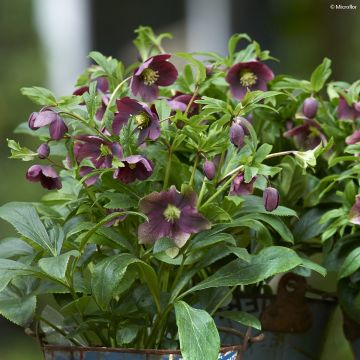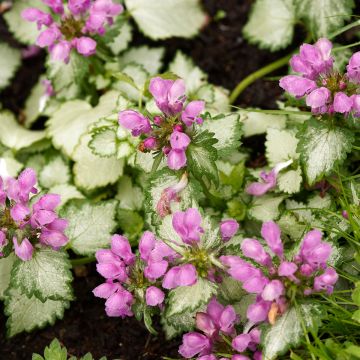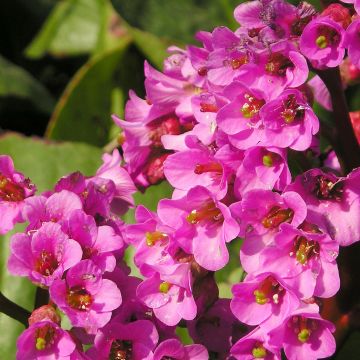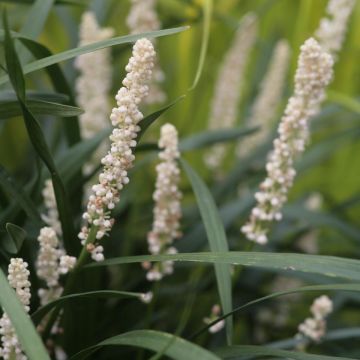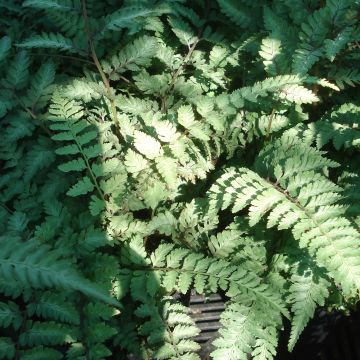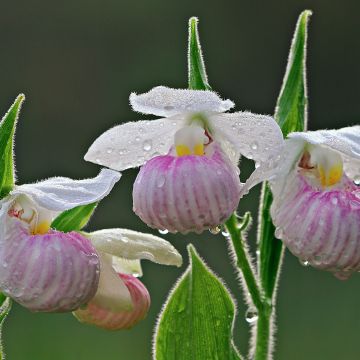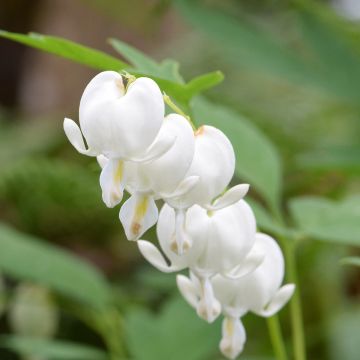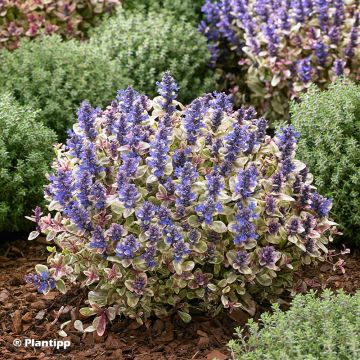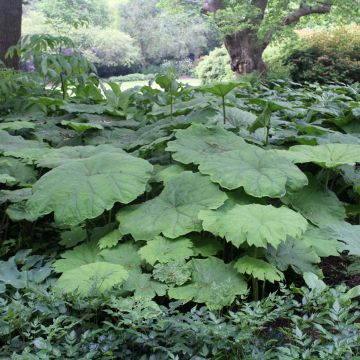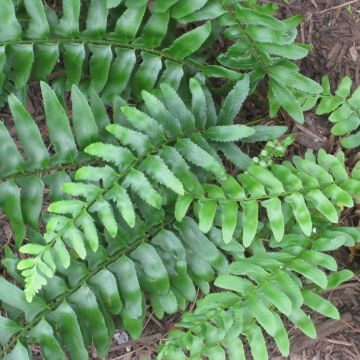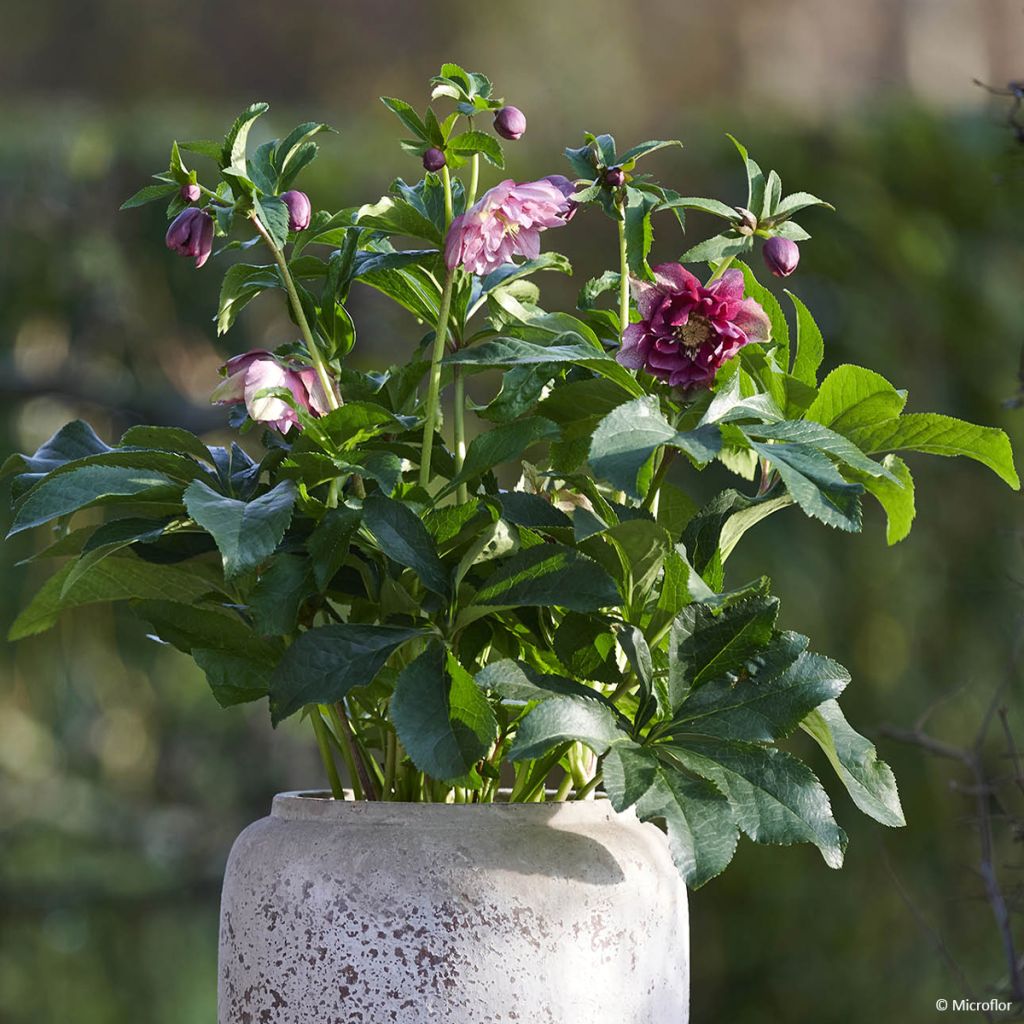

Hellébore ViV® Catharina - Helleborus orientalis
Helleborus hybridus ViV Catharina
Helleborus x hybridus ViV® Catharina
Lenten Rose, Oriental Hellebore
Why not try an alternative variety in stock?
View all →This plant carries a 12 months recovery warranty
More information
We guarantee the quality of our plants for a full growing cycle, and will replace at our expense any plant that fails to recover under normal climatic and planting conditions.
From €5.90 for pickup delivery and €6.90 for home delivery
Express home delivery from €8.90.
Does this plant fit my garden?
Set up your Plantfit profile →
Description
Oriental Hellebore Catharina is a variety of the Viv series with very early flowering. Appearing from October and for several weeks, this flowering is highlighted by the dark evergreen foliage, decorative all year round. The very double flowers are deep pink, veined with dark pink, with a yellow stamen centre forming a pleasant contrast with the petals. This hardy perennial forms a beautiful clump that grows in light to dense shade depending on the climate.
Hellebores of the ViV series are obtained through in-vitro multiplication. Unlike varieties obtained through seed multiplication, Hellebores produced by in-vitro guarantee flowering rigorously identical to the variety they come from. They have the same genetic characteristics as the mother plant, are more vigorous, and develop uniformly.
Hellebore Catharina belongs to the Ranunculaceae family, which includes about sixty genera and around 2500 species, mostly herbaceous. The species Helleborus orientalis is native to Greece, Turkey, and the centre and east of the Caucasus. It is a perennial plant that readily hybridizes with other species to produce many hybrids with varied colours and forms. Names of varieties are rarely given to these hybrids, they are distinguished by their shape and colour. Oriental Hellebore is a hardy plant that can tolerate temperatures as low as -15 °C, naturally growing in forests, thickets, and clearings up to 2,000 m (2,187 yards) altitude.
Catharina forms a clump that reaches 45 to 55 cm (18 to 22in) in height and about forty in width, which will grow in light shade of deciduous trees or even in denser shade, such as that found in the undergrowth. Its growth consists of palmate basal leaves, slightly dentate, dark green and glossy. These are evergreen leaves which actually live for only 8 months and are regularly replaced by new leaves. They provide a perfect dark background that highlights the flowers from October until February, depending on the climate. These flowers are very double, with beautiful pink petals finely veined with darker pink surrounding a well-filled heart of yellow stamens that harmonizes perfectly with the pink petals. Like other varieties, they are pendulous, allowing water to slide off like an umbrella, protecting the flower's heart from rotting. Hellebores do not like to be moved once established, and young plants sometimes take time to bloom, so be careful to choose their location well when planting.
This Hellebore has graceful flowers that stand out well from the foliage and will be perfect in a partially shaded bed to brighten up autumn during dark days. Plant it alongside Autumn Asters like the Aster ageratoides 'Starshine', which forms a carpet of small star-shaped white flowers from July to October. You can also focus on staggered blooming to enjoy flowers for a large part of the year. For winter, there are plenty of other varieties of Hellebores that offer white, green, pink, or red flowers until early spring, when the Epimediums take over with their colourful small and graceful flowers. Finally, the superb Heucheras will bring the beauty of their multicoloured foliage - pink, red, chocolate, gold, purple - among the most decorative in the plant kingdom, as well as the charm and lightness of their early summer flowering.
Report an error about the product description
Flowering
Foliage
Plant habit
Safety measures
Botanical data
Helleborus
x hybridus
ViV® Catharina
Ranunculaceae
Lenten Rose, Oriental Hellebore
Cultivar or hybrid
ingestion
Cette plante est toxique si elle est ingérée volontairement ou involontairement.
Ne la plantez pas là où de jeunes enfants peuvent évoluer, et lavez-vous les mains après l'avoir manipulée.
Pensez à conserver l'étiquette de la plante, à la photographier ou à noter son nom, afin de faciliter le travail des professionnels de santé.
Davantage d'informations sur https://plantes-risque.info
Other Oriental Hellebore
Planting and care
Oriental Hellebore Catharina grows in any neutral to moderately chalky soil, rich, light or clayey, in partial or light shade, sheltered from cold and dominant winds. Avoid direct sunlight during the hottest hours in the south. This perennial should be planted from early autumn to spring. It thrives in deeply cultivated soil mixed with organic matter. To feed, use bone meal or another organic fertilizer. Water well after planting and add a layer of mulch 2 to 5 cm (1 to 2in) thick. Regularly remove faded leaves to improve flowering. Ensure a planting distance of 35 to 45 cm (14 to 18in) between each plant to promote their development. Hellebore does not tolerate stagnant water as it may cause it to rot.
The roots should not completely dry out in summer. Hellebores can be affected by a fungal disease transmitted by aphids, known as black spot. Remove the spotted leaves from evergreen species when the flower buds appear. Remove faded flowers after seeding. They can also suffer from grey rot or die from collar rot due to poor growing conditions in overly wet situations.
On a balcony or terrace, plant this perennial in a pot 4 to 5 times larger than it, as it needs space to develop its root system. This Hellebore can withstand temperatures down to -15 °C or even lower, allowing it to adapt to almost all regions.
Planting period
Intended location
Care
This item has not been reviewed yet - be the first to leave a review about it.
Shade-loving perennials
Haven't found what you were looking for?
Hardiness is the lowest winter temperature a plant can endure without suffering serious damage or even dying. However, hardiness is affected by location (a sheltered area, such as a patio), protection (winter cover) and soil type (hardiness is improved by well-drained soil).

Photo Sharing Terms & Conditions
In order to encourage gardeners to interact and share their experiences, Promesse de fleurs offers various media enabling content to be uploaded onto its Site - in particular via the ‘Photo sharing’ module.
The User agrees to refrain from:
- Posting any content that is illegal, prejudicial, insulting, racist, inciteful to hatred, revisionist, contrary to public decency, that infringes on privacy or on the privacy rights of third parties, in particular the publicity rights of persons and goods, intellectual property rights, or the right to privacy.
- Submitting content on behalf of a third party;
- Impersonate the identity of a third party and/or publish any personal information about a third party;
In general, the User undertakes to refrain from any unethical behaviour.
All Content (in particular text, comments, files, images, photos, videos, creative works, etc.), which may be subject to property or intellectual property rights, image or other private rights, shall remain the property of the User, subject to the limited rights granted by the terms of the licence granted by Promesse de fleurs as stated below. Users are at liberty to publish or not to publish such Content on the Site, notably via the ‘Photo Sharing’ facility, and accept that this Content shall be made public and freely accessible, notably on the Internet.
Users further acknowledge, undertake to have ,and guarantee that they hold all necessary rights and permissions to publish such material on the Site, in particular with regard to the legislation in force pertaining to any privacy, property, intellectual property, image, or contractual rights, or rights of any other nature. By publishing such Content on the Site, Users acknowledge accepting full liability as publishers of the Content within the meaning of the law, and grant Promesse de fleurs, free of charge, an inclusive, worldwide licence for the said Content for the entire duration of its publication, including all reproduction, representation, up/downloading, displaying, performing, transmission, and storage rights.
Users also grant permission for their name to be linked to the Content and accept that this link may not always be made available.
By engaging in posting material, Users consent to their Content becoming automatically accessible on the Internet, in particular on other sites and/or blogs and/or web pages of the Promesse de fleurs site, including in particular social pages and the Promesse de fleurs catalogue.
Users may secure the removal of entrusted content free of charge by issuing a simple request via our contact form.
The flowering period indicated on our website applies to countries and regions located in USDA zone 8 (France, the United Kingdom, Ireland, the Netherlands, etc.)
It will vary according to where you live:
- In zones 9 to 10 (Italy, Spain, Greece, etc.), flowering will occur about 2 to 4 weeks earlier.
- In zones 6 to 7 (Germany, Poland, Slovenia, and lower mountainous regions), flowering will be delayed by 2 to 3 weeks.
- In zone 5 (Central Europe, Scandinavia), blooming will be delayed by 3 to 5 weeks.
In temperate climates, pruning of spring-flowering shrubs (forsythia, spireas, etc.) should be done just after flowering.
Pruning of summer-flowering shrubs (Indian Lilac, Perovskia, etc.) can be done in winter or spring.
In cold regions as well as with frost-sensitive plants, avoid pruning too early when severe frosts may still occur.
The planting period indicated on our website applies to countries and regions located in USDA zone 8 (France, United Kingdom, Ireland, Netherlands).
It will vary according to where you live:
- In Mediterranean zones (Marseille, Madrid, Milan, etc.), autumn and winter are the best planting periods.
- In continental zones (Strasbourg, Munich, Vienna, etc.), delay planting by 2 to 3 weeks in spring and bring it forward by 2 to 4 weeks in autumn.
- In mountainous regions (the Alps, Pyrenees, Carpathians, etc.), it is best to plant in late spring (May-June) or late summer (August-September).
The harvesting period indicated on our website applies to countries and regions in USDA zone 8 (France, England, Ireland, the Netherlands).
In colder areas (Scandinavia, Poland, Austria...) fruit and vegetable harvests are likely to be delayed by 3-4 weeks.
In warmer areas (Italy, Spain, Greece, etc.), harvesting will probably take place earlier, depending on weather conditions.
The sowing periods indicated on our website apply to countries and regions within USDA Zone 8 (France, UK, Ireland, Netherlands).
In colder areas (Scandinavia, Poland, Austria...), delay any outdoor sowing by 3-4 weeks, or sow under glass.
In warmer climes (Italy, Spain, Greece, etc.), bring outdoor sowing forward by a few weeks.

































